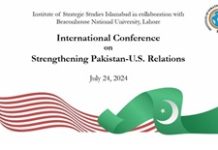Keynote Address
Lieutenant General (Retd) Sarfaraz Sattar HI (M), former Director General, Strategic Plans Division (SPD), at the ACDC-ISSI Book Launch – August 31 2023
- Let me begin by thanking Amb. Sohail Mehmood for inviting me to ISSI as Chief Guest for the launching of this book on ‘Emerging Threats and Shifting Doctrines’. Needless to say that, I am delighted and honored to be here on my maiden appearance; But to be honest it came as a bit of a surprise to me when one morning I was told that there was an invitation letter for me for the event. And frankly being in double mind I asked for the book before I gave consent. Over the next two-three days when I read the book gradually absorbing each chapter, my mind was made up. Not only due to the excellent quality of articles (which are few and far between in Islamabad) but also due to the fact that the topics this book takes up are of a contemporary nature which are all also closely related to strategic stability, a subject close to my heart. I thus had to come here to commend the work of each contributing author and also that of the compilers and editors for putting together a book of such immense value/importance. I will come to the book in a while, but before I do that, let me first make an opening statement; which is that:-
“The world is entering a new nuclear era. All the major nuclear powers i.e. USA, China, and Russia – are engaging in renewed arms races and nuclear modernization programs. The regional nuclear powers are also expanding and modernizing their own arsenals and are increasingly tempted by the Cold War’s most dangerous tendencies such as Counter Force and Damage Limitation Strategies”.
- Ladies and gentlemen, this opening statement that I just read out is not mine, but the final word from Vipin Narang’s latest book, on strategies of nuclear proliferation “Seeking the Bomb”. The book was published just last year by Princeton University Press. What are the catchwords here, ‘Renewed Arms Races’, ‘Nuclear Modernization’, and ‘Counter Force and Damage Limitation Strategies’ and as he asserts, all this is being done by all major powers as well as by regional nuclear powers. Since we are flanked by both a major and a regional power; So this in a nutshell is the environment we live in today. At such a time and when so much is being debated and written about it internationally, the publishing of this book, “Emerging Threats and Shifting Doctrines”, for which we are all gathered here today is the second breath of fresh air coming from our ‘Strategic Community’ this year. The first of course was the book ‘Pakistan’s Nuclear Deterrence and Diplomacy’ by Amb. Zamir Akram published earlier this year; in which he has most wonderfully traced ‘with our perspective’ the history of Pakistan’s acquisition of nuclear weapons capability. This is something that needs to be done repeatedly because the international community led by some of the Indian, so-called international security experts and scholars, like Vipin Narang and Ashley Tellis (who’s book-‘Striking Asymmetries-Nuclear Transition in South Asia’ also came out last year) both of them in a well-planned onslaught have branded Pakistan as, ‘The biggest nuclear proliferator with risky nuclear behavior and a persistent cause of concern for the international community”. Whereas in reality, it is our eastern neighbor, India, which is feverishly indulging in an unprecedented increase in its fissile material stockpile, is pursuing the acquisition of all kinds of latest weapon systems and technologies posing great risk to the region and beyond.
- Now coming over to today’s book and my impressions about it. Of course, you have heard all the writers and the experts, which leaves little room for me to comment. But since each of the seven chapters touches the most contemporary subjects arranged in a very logical sequence; I feel that each one presents seminal work, which will most certainly influence the work of future researchers in each field. I will very briefly comment upon each chapter as each deals with a separate topic and then wrap up with some final thoughts. Let me first of all state that since the book deals with both scientific and doctrinal developments, this is a continual quest and both are intrinsically linked as most of the time scientific developments drive the development of new doctrines and sometimes it is the other way around. More than ever before, Pakistan is faced with an existential threat from a regional bully and a hegemon, who for some time now also happens to enjoy unprecedented US and Western patronage. We thus need to not only remain cognizant of these developments but also match the race wherever our survival/existence demands. And in this game, one thing is certain that power draws respect and prestige, and also that when the chips are down you are alone to fend for yourselves, no one comes to your rescue or help if you are not strong from within.
- Okay, coming to the first Chapter of the book, which covers complete details about developing Indian Ballistic Missile Defence (BMD) capabilities and the assistance it is receiving in the field from Russia, the USA, and Israel, who are helping Indians along with transfer of technology for both missiles and accompanying radars. Similarly, it also brings out aptly that with the signing of BECA the “Basic Exchange & Cooperation Agreement” with the US, India is enabled to access the USA’s geo-special intelligence for military purposes thus giving a great fillip to Indian ISR capabilities. It also covers details about the Indian quest for the acquisition of hypersonic & other long-range ballistic missiles including SLBMs. The chapter very correctly concludes that the development of all these capabilities will induce greater deterrence instability in South Asia. Let me state in this regard, that not only that our defence planners are fully cognizant of all these developments whereby thorough technical and scientific analysis of each development is done to know the true capabilities of each system but also own systems are pitched against all these for a threadbare assessment and upgrading them to validate their efficacy and ensure survivability. We have therefore seen in recent years, the introduction of missiles with ‘maneuverable’ capabilities, missiles with capabilities like ‘Skip and Glide’, and the introduction of MIRV capable systems in our inventory. With all these developments, no known BMD system in the world will be able to neutralize our ballistic missiles of various ranges. The enemy planners may, therefore, be cautioned not to live in false illusions, as Pakistan defence planners have and will never let the deterrence game slip out of their hands. (Let me also say here that, though, your research and good work enable the planners to correctly point out the fast-developing and destabilizing Indian capabilities to the world), all of us must also maintain complete faith in our own capabilities and systems.
Since missiles are basically of two types, ballistic and cruise while the former has been covered a few words about the latter are also pertinent here, the chapter very clearly talks about the feverish pace with which India is developing a large contingent of supersonic cruise missiles and is also pursuing the development of hypersonic weapons with foreign collaboration, while there is also a talk of raising of separate rocket force espousing the concept of Non-Contact Warfare. On our part, there is only a need to clearly spell out our own doctrine to counter such threats – the capability exists. The answers are many starting from responding in kind to eliminating centers of origin of such missile systems; only a clear resolve needs to be articulated for putting at rest any misperceptions. The World Community particularly the West needs to realize that giving unbridled access to such technology to India, with a total technological blackout towards Pakistan, is pushing South Asia towards destabilization. Let me also say here that the hopes pinned on India for delivering against China in the Great Power rivalry will never materialize. This is not only evident when we look at the bilateral trade figures between India and China but also in the Indian states’ behavior vis-a-vis China during its border skirmishes in recent years, as well as the Indian diplomacy and entry into various upcoming multilateral bodies/organizations. India is simply piggybacking on the West for closing the technology gap and raising its stature and clout.
- Moving on to the 2nd Chapter which presents the most avid analysis of Indian missiles and ISR capabilities and the resultant shift in its doctrines. It analyses this changing dynamic from all angles i.e., it pieces together the Indian ballistic and cruise missiles programs coupled with a detailed and clear picture of the Indian nuclear submarine program, its satellite development, and canisterisation of land-based systems, pointing to clear indicators of India moving away from ‘Recessed’ to ‘Ready’ Deterrence. On the doctrinal side, the chapter very clearly points out various policy statements by some of Indian political and military leadership in recent years about rethinking of its declared nuclear doctrine and moving towards a Pre-emptive Counter Force Posture. This is happening despite the fact that some of the key capabilities (required for the purpose), like BMD shield, the Hypersonic missiles, and space-based systems are yet to fully materialize. Some very pertinent and appropriate response options for Pakistan are also espoused in the chapter with the correct conclusion that current Indian capabilities cannot destroy Pakistan’s Nuclear Forces in a decapitating first strike. But in addition to all the measures suggested and the conclusions drawn, some countermeasures like neutralizing capability hubs (which are static and built-in peacetime) also need to be brought into focus as a response option by us in the Non-Contact phase of the war. Also in response to any misadventure seeking to achieve limited objectives, Pakistan’s policy of ‘Quid Pro Quo plus’ gives it the liberty of action to choose from an entire range of options. A final point here is that given Pakistan’s current capabilities and widespread, neither India nor any other power will be able to take out our entire assets in all three services in a decapitating first strike.
- Ladies and gentlemen moving on to chapter 3. The chapter brings out a detailed analysis of Indian military modernization and the resultant aggressive behavior and its reliance on military means to settle disputes on own terms. It also correctly concludes the need to promote a Strategic Restraint Regime, Arms Control and Conventional Force Balance in South Asia. But let me state here that when you are dealing with a regional hegemon which has a history of coercive behavior towards all its smaller neighbors and its strategic thought is still based in Chankya’s principles – (Arthshastra by the way, is taught even today in New Delhi’s National Defence College as part of curriculum), we therefore have to be prepared with all options with full resolve, force of conviction and faith. It is not a game for the faint-hearted – more on this at the end.
- Moving onto chapter 4, which is on ‘Nuclearization of Indian Ocean’. Submarines, of course, are the most assured form of second-strike platforms. The history of Indian SSBN development, with Russian assistance, and their current capabilities and future plans have been very ably covered and so has the history of accidents (like flooding of Arihant & blowing away of hatch of Arighat) have been correctly pointed out. The attendant problems of safety/security and safekeeping of Nuclear Weapons on board submarines plus the issue of nuclear weapons being kept in ‘Ready Deterrence’ state have also been appropriately pointed out in the chapter. Let me qualify here, that when you look at the history of Indian submarine operations you find that the Indian Navy has been rather poor at handling even its conventional fleet and their track record is replete with a string of accidents due to negligence and incompetence. I say so as, there is a case for our researchers to go into the complete history of Indian Navy Submarine operations and compare it to that of the Pakistan Navy to draw pertinent lessons for analyzing what could or is likely to be the fate of Indian SSBN’s given the Indian Navy’s prowess and training standards. The world also needs to be reminded of what they are handing over to Indians and what impact it is likely to have on deterrence stability in South Asia and beyond. There is, therefore, a serious case for the international community to compel and convince India to sit down for confidence-building measures in the field since it will have implications for the entire region and beyond.
- The next i.e., (5th) chapter on ‘Indian Space Program’ is equally well researched with up-to-date information about complete Indian space capabilities. It most aptly identifies the historical evolution of Indian space efforts, which started its journey in 1962. It has rightly been identified that it was built on US assistance since the 1970’s, followed by erstwhile the USSR and now Russia and the latest third entrant in this cooperation/ collaboration is Israel. Had it not been for such direct help, like the supply of cryogenic engine technology by the USSR and assistance from the US after the 2004 Indo–US agreement, The NSSP (Next Step in Strategic Partnership), or the Israeli assistance in building the SAR capable satellites India would never be standing where it is today. The complete range of its satellites i.e., communication, remote sensing, meteorology, and Navigation (with 21 dedicated military satellites), and its ASAT cap have also been correctly pointed out. With their successful lunar landing week before last and the ongoing space shuttle program, India is now firmly in the league of Space Faring Nations. Its ‘Elint Cluster’, ‘Soft kill LASER system’, and ‘Satellite and Navigation Jamming System’ are also upcoming serious cutting edge capabilities. The development of the Indian MRBM and ICBM Program are also, said to be direct spin-offs/derivatives from its satellite program. The most important point to note here is; that in contrast to the Indians, Pakistan has been suffering from knowledge and technological apartheid not only in this but also in all other scientific fields as well, from the very beginning. However, despite all this, our planners/policymakers and scientists have not been sitting idle. We currently have three operational satellites in both the communication and remote sensing categories, with the 4th one coming early next year. Our 2047 Satellite Space Plan with 21 satellites (7 each in remote sensing, Navigation and Communication fields) stands approved from the NCA in 2018, which takes care of all of Pakistan’s needs, and is on track. However two things are important to note in this regard; one that putting up satellites is an expensive business as each satellite costs around US$250–300 million and secondly that satellites are like ice cubes, the moment you put it up there it starts melting and you have to start arranging for its replacement. My last point on the subject is regarding the Indian ASAT capability. India demonstrated this capability by targeting one of its phased-out LEO satellites at 285 km height. LEO category of satellites generally operate up to heights of 700 – 900 Kms where as others like communication satellites operate at a heights of up to 36000 km. So there is more to it than meets the eye.
- The last two chapters dealing with ‘doctrinal shifts’ & Lethal Autonomous Weapons’ are somewhat interlinked, therefore I will comment on them together. So whether, it is the Directed Energy Weapons (DEWs), Killer Robots, UAV’s/AUV’s, or the introduction of Hypersonic weapons or MIRV’s capable missiles, all using AI technology with the aim to disrupting, denying or destroying enemy’s war waging potential. India is trying to enter the entire league of things affecting future conflicts. (We can put this in the correct perspective if we look at the following quote from former Indian Army Chief, Gen. M. M Naravane, ‘Military ascendancy can be established in short cycles of conflict that do not necessarily lead to war’ and that India is in the process of adopting a new doctrine, the non-contact warfare (NCW) doctrine’. Therefore, ladies and gentlemen, we need to brace ourselves and be ready for future conflict where we see the application of such force to gain ascendancy over a short span of time. There is already talk of such a thing happening in the run-up to the next Indian elections. But let me conclude here by saying that whether it be, such an limited conflict that India seeks to manage or a large skirmish or a conflict in Kashmir or elsewhere our policymakers remain focused and fixed with our time-tested and well-reasoned and thought-out concept of ‘QPQ plus’ response to any misadventure and our commitment to the principle of ‘NO SPACE FOR WAR’. We must also recognize that India – a Nuclear Power, is a regional bully, with hegemonic designs, which is emboldened by the day due to the embrace of the West. India will thus continue to coerce and force us either “to fight” or “to start giving in”. This leaves us only with one choice; Try to defeat ‘the hegemon’ with whatever means are available to us, short of war. But if war is imposed, then to do whatever it takes to win it, by improving the co-relation of forces at the point of decision. This is not a game for the faint-hearted as it sits at the heart of our national survival and only people with the utmost resolve and the strongest faith in ALLAH Almighty are fit for this contest. At the end let me conclude by quoting from John F Kennedy’s October 22, 1962 speech, which he made at the end of the Cuban Missile Crisis; which as you all know took place at the height of the Cold War. As the history of this crisis holds a numerous of lessons, from which we can learn a lot since it somewhat suits our environment.
“Aggressive Conduct, if allowed to go unchecked, ultimately leads to war. Our goal is not the victory of might but the vindication of right. Not peace at the expense of freedom, but both peace and freedom in our region”.
Ladies and gentlemen before I depart let me once again commend the work of all the worthy writers and the compiling and editing team of the Arms Control and Disarmament Center – ISSI, for putting together a book of this high value and intellect. That’s all that I had to say. I thank you all for a very patient and keen hearing.
















